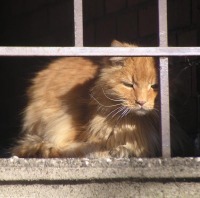Help Cats Who Live on the Streets

Pittsburgh’s Homeless Cat Management Team is hosting a Volunteer and Caretaker meeting on Sunday, December 13, 2009 at Atria’s Restaurant near PNC Park. For more information, visit HCMT’s website at www.homelesscat.org.
This is the group that holds no-cost or low-cost spay and neuter events for stray and feral cats only, and helps people who are caring for colonies of stray and feral cats.
You may have heard about feral cat colonies, or groups of stray cats inhabiting abandoned buildings or the garage in your back yard, and you may have heard people say they are just a “nuisance” and should be “exterminated”.
Not so–they are peoples’ cast-offs who usually end up on the street through no fault of their own. Cats don’t choose to be strays, but end up out there after being abandoned by owners who no longer want them, very often females with kittens left to fend for themselves or cats left behind when owners moved on. These are considered strays, while feral cats are those born outside of human contact, often to mother cats who have also had no human contact so they are more like wild animals than the loving and playful cats we know. Often cats allowed to roam outdoors will join the colony, too.
Unlike the popular myth that cats can survive on their own and are exclusively solitary hunters, cats will instead seek safe shelter and a ready food source as well as the company of other cats for safety and survival. Therefore, a garage in an alley with a dumpster nearby becomes a place for the group to collect, and a stray/feral colony is formed. Likewise, in isolated or wooded areas where people tend to “dump” unwanted cats and kittens, they will gravitate to the nearest house or facility if food is readily available. In both cases, urban and rural, unaltered cats will reproduce and the colony will grow.
If no one steps up to take care of them they usually become the targets of abuse or anger, and without vaccinations they also harbor and spread feline diseases that would otherwise be kept under control.
For years, countless individuals have taken bags of cat food to cat colonies in parks and isolated areas as well as the alleys and abandoned buildings of cities. Often, this person will find themselves feeding a small group which continues to grow through the addition of kittens born to colony members and individual cats who are dumped where people see cats gathering, and before long the generous person is overwhelmed with the number of hungry mouths to feed and the sight of injuries and illness.
HCMT assists these people in providing spay/neuter and low-cost medical care for stray and feral cats, as well as people who care for individual stray cats.
Cats don’t belong in colonies living at such risk. Even if you can’t manage a colony or donate time to their effort, at least let HCMT know you thank them for the work they do, and consider making a donation to help offset the costs of surgery, vaccinations and treatment.


Pingback: Winter Tips for Pets and Outdoor Animals « The Creative Cat